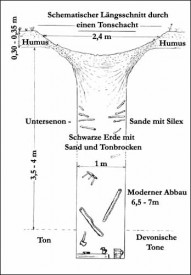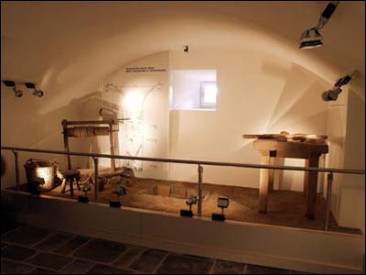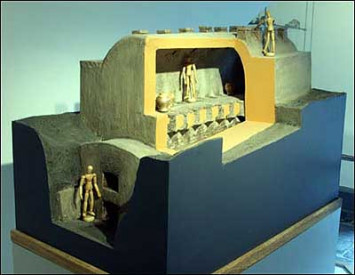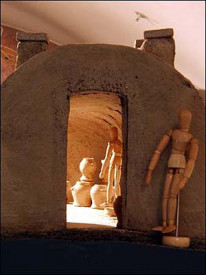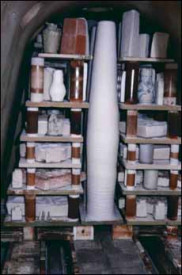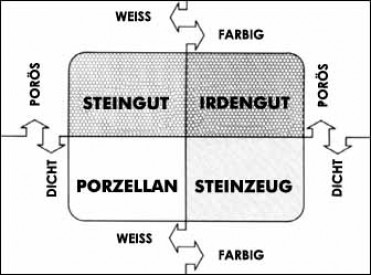Technical evolutionsExport & tradingFor house and farmArchaeoloyRenaissance stonewareSpecial formsThe master pottersConcurrences on all frontsEverything has an end ...
Technical aspects
Fired earth
A single raw material, clay, renders an almost unbelievable diversity in form, colour and decoration. All of this is ceramics. Two large groups can be distinguished:
• densely fired (sintered) ceramics
- stoneware and porcelain
• undensely fired (unsintered) ceramics
- earthenware, terracotta, faience, Majolika, Raku.
After the mining, the clay had to be moistened in order to make it workable. The clay fermented in those pits and was then treaded and trampled.
On the workbench the lumps of clay were cut, rolled and beaten. By this procedure all remaining impurities and air bubbles were removed.
In the Rhenish pottery towns not a potter's disc but a potter's wheel was used.It was put into motion with a large stick and was then turning up to an hour.
A ceramic vessel is created in different stages. After being centered in the middle of the potter's wheel, the lump is broken up and a cylinder is formed. The final form is worked out of this cylinder.
Cross section of an old shaft of clay in Lichtenbusch
Early kilns were circular and vertical. Their walls were partly filled with defective pieces.
1 – furnace
2 – firing chamber
3 – fastened firing grid
4 – apertures through which fumes could escape
5 – defective pieces with which the walls were filled in for isolation
From the 16th century on, special kilns were used for the firing of stoneware.
These kilns were much bigger and horizontal.
1 – access door to the kiln
2 – furnace
3 – firing chambers
4 – floor of the kiln with canals for the flames
5 – firing chamber with stacked jugs
6 – apertures through which fumes could escape and salt could be introduced
7 – kiln roof on which it was possible to walk
Aid in firing
In the kiln, the piled-up vessels had to be separated from each other with firing aids. Those are little clay tiles. In Raeren they were called "Krätzchen". Sprinkled with sand they guaranteed that the jugs could later be easily separated. Those firing aids could only be used once. Therefore they were later used to tile the floor with. One of those floors can be seen in the lecture hall of the museum and in the rebuilt pottery workshop.
Kiln for stoneware with modern ceramics and modern firing aids
Black, crooked and wrongly fired
During the firing of stoneware a lot of things could go wrong due to the power of the fire. Around 30% of the contents of a kiln had stains from the firing, an inadequate glaze, were misshapen or wrongly dyed. Sometimes whole piles of jugs collapsed and destroyed parts of the contents of the kiln. The strict quality controls achieved that only perfect pieces could be exported. Jugs with small faults were allowed to be sold in the surrounding area at a reduced price. Defective pieces were thrown into the shred ditches next to the kilns and were destroyed there. Nowadays they are found in excavations in whole Raeren.
The flames leaping out of the stoneware kiln are several metres high
The burning heat of hell
Only from the 16th century on, the course of fire could be well regulated. Such a firing of stoneware lasted several days. The kiln had to be fired night and day. The temperature rose at least to 1250 degrees Celsius. This is a real hellfire. For glazing, about 400 kilos of sodium chloride (NaCl) were strewn into the kiln through venting holes. The fumes of soda form the glaze of the blazing ceramics. The fumes of chloride escape inwhite clouds.
Text by Töpfereimuseums Raeren, info@toepfereimuseum.org

